Western wildfires’ health risks extend across the country
Those fires devastating communities in the West send bad air traveling, boosting emergency room visits in the East
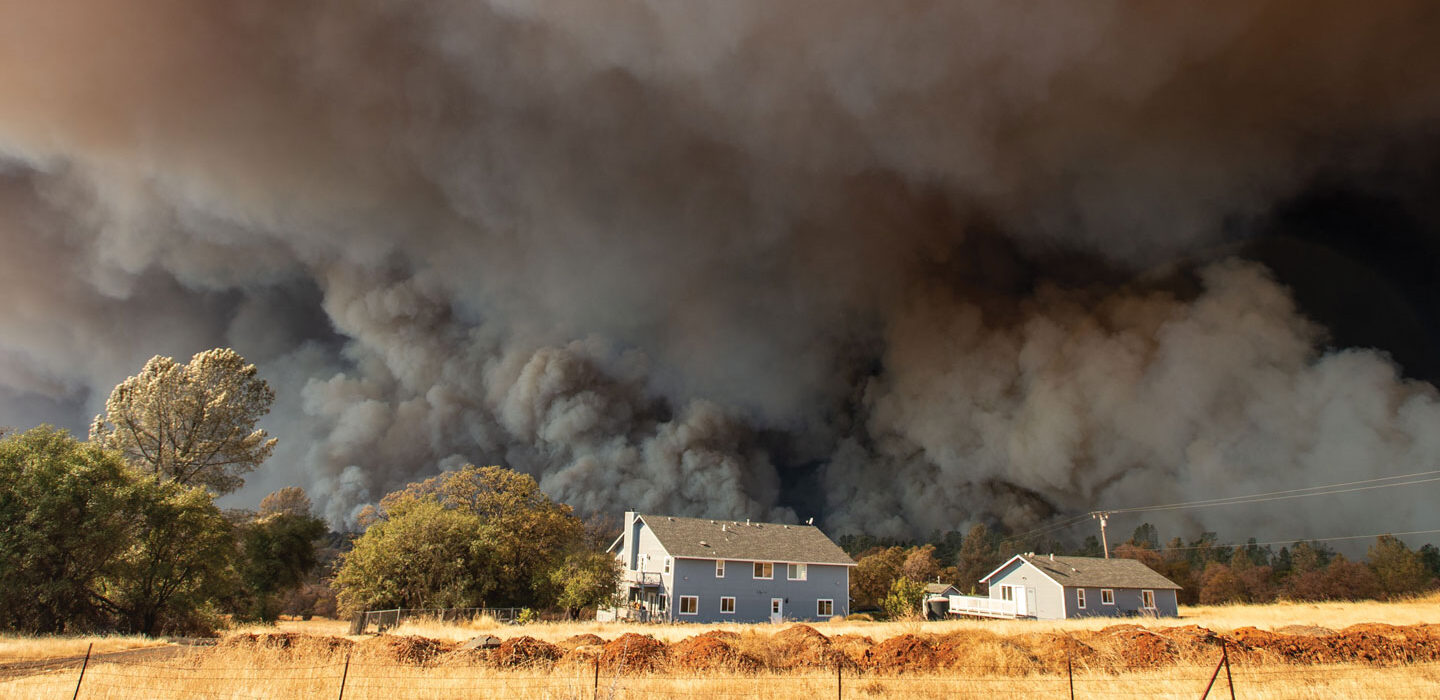
Western wildfires, like the 2018 Camp Fire in Paradise, Calif., are devastating for local communities. Their smoke also travels to heavily populated areas to the east. Researchers are beginning to study the health effects for people far from the fires.
JOSH EDELSON/AFP VIA GETTY IMAGES
By Megan Sever
JUNE 17, 2022
After a relaxing day at the Jersey Shore last July, Jessica Reeder and her son and daughter headed back home to Philadelphia. As they crested a bridge from New Jersey into Pennsylvania, they were greeted with a hazy, yellow-gray sky. It reminded Reeder of the smoky skies she saw growing up in Southern California on days when fires burned in the dry canyons.
Smelling smoke and worried about her asthma and her kids, Reeder flipped the switch to recirculate the air inside the car instead of drawing from the outside. At home, the family closed all the windows and turned their air purifiers on high.
The smoke had traveled from fires raging on the other side of the continent, in the western United States and Canada. Although air quality in Philadelphia didn’t come close to the record-bad air quality that some western cities experienced, it was bad enough to trigger air quality warnings — and not just for people with asthma or heart problems.
Most large U.S. wildfires occur in the West. But the smoke doesn’t stay there. It travels eastward, affecting communities hundreds to thousands of kilometers away from the fires. In fact, the majority of asthma-related deaths and emergency room visits attributed to fire smoke in the United States occur in eastern cities, according to a study in the September 2021 GeoHealth.
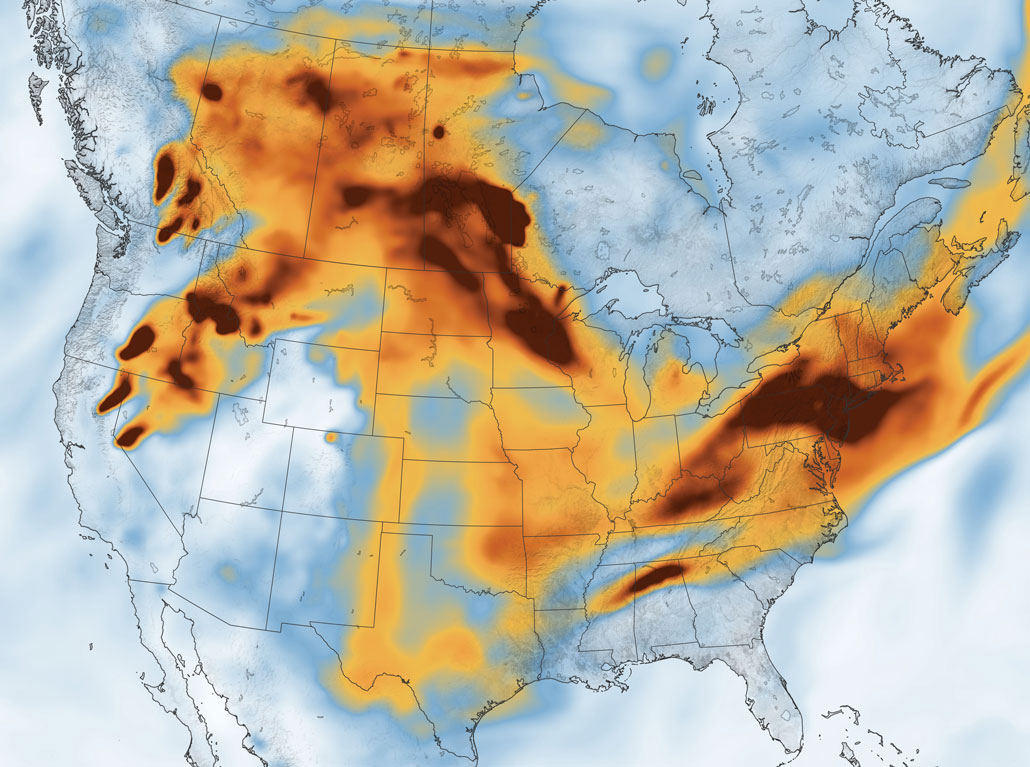
Smoke poured into the eastern United States and Canada from wildfires in the West on July 21, 2021 (darker red is denser smoke). Residents of eastern cities received code orange and code red warnings that air quality was unhealthy.
JOSHUA STEVENS/NASA EARTH OBSERVATORY
The big problem is fine particulate matter, tiny particles also known as PM2.5. These bits of ash, gases and other detritus suspended in smoke are no more than 2.5 micrometers wide, small enough to lodge in the lungs and cause permanent damage. PM2.5 exacerbates respiratory and cardiovascular problems and can lead to premature death. The particles can also cause asthma and other chronic conditions in otherwise healthy adults and children.
Over the last few decades, U.S. clean air regulations have cut down on particulate matter from industrial pollution, so the air has been getting cleaner, especially in the populous eastern cities. But the regulations don’t address particulate matter from wildfire smoke, which recent studies show is chemically different from industrial air pollution, potentially more hazardous to humans and increasing significantly.
So far, a lot of the research on how wildfire PM2.5 can make people sick has been based on people living or working near fires in the West. Now, researchers are turning their attention to how PM2.5 from smoke affects the big population centers in the East, far from the wildfires. One thing is clear: With the intensity and frequency of wildfires increasing due to climate change (SN: 12/19/20 & 1/2/21, p. 32), people across North America need to be concerned about the health impacts, says Katelyn O’Dell, an atmospheric scientist at George Washington University in Washington, D.C.
The big problem is fine particulate matter, tiny particles also known as PM2.5. These bits of ash, gases and other detritus suspended in smoke are no more than 2.5 micrometers wide, small enough to lodge in the lungs and cause permanent damage. PM2.5 exacerbates respiratory and cardiovascular problems and can lead to premature death. The particles can also cause asthma and other chronic conditions in otherwise healthy adults and children.
Over the last few decades, U.S. clean air regulations have cut down on particulate matter from industrial pollution, so the air has been getting cleaner, especially in the populous eastern cities. But the regulations don’t address particulate matter from wildfire smoke, which recent studies show is chemically different from industrial air pollution, potentially more hazardous to humans and increasing significantly.
So far, a lot of the research on how wildfire PM2.5 can make people sick has been based on people living or working near fires in the West. Now, researchers are turning their attention to how PM2.5 from smoke affects the big population centers in the East, far from the wildfires. One thing is clear: With the intensity and frequency of wildfires increasing due to climate change (SN: 12/19/20 & 1/2/21, p. 32), people across North America need to be concerned about the health impacts, says Katelyn O’Dell, an atmospheric scientist at George Washington University in Washington, D.C.
Bad air travels
Air pollution regulations limit PM2.5 from exhaust-emitting cars and trucks and fossil fuel–burning factories and power plants. These regulations have done “a really good job” reducing anthropogenic air pollution in the last couple of decades, says Rosana Aguilera, an environmental scientist at the Scripps Institution of Oceanography in La Jolla, Calif. In the United States, concentrations of six of the most common air pollutants have dropped by 78 percent since the Clean Air Act of 1970, according to the U.S. Environmental Protection Agency. PM2.5 concentrations have come down as well — at least until recently.
Western wildfires, which are growing more frequent, more severe and larger, are erasing some of the gains made in reducing industrial pollution, says Rebecca Buchholz, an atmospheric chemist at the National Center for Atmospheric Research in Boulder, Colo.
Fires in the Pacific Northwest are “driving an upward trend” in particulate matter air pollution, Buchholz and colleagues wrote April 19 in Nature Communications. Such smoke pollution peaks in August when fires in the region tend to spike and the atmosphere’s ability to clean itself through, say, rain, is limited. This spike of late-summer air pollution is new, Buchholz says. It’s especially noticeable since 2012.
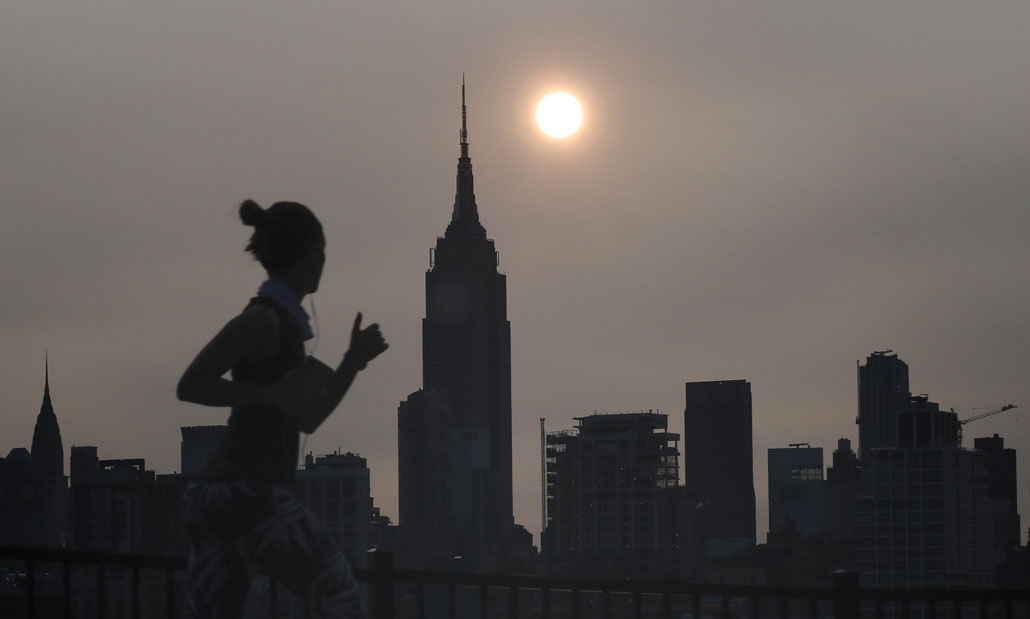
Air pollution regulations limit PM2.5 from exhaust-emitting cars and trucks and fossil fuel–burning factories and power plants. These regulations have done “a really good job” reducing anthropogenic air pollution in the last couple of decades, says Rosana Aguilera, an environmental scientist at the Scripps Institution of Oceanography in La Jolla, Calif. In the United States, concentrations of six of the most common air pollutants have dropped by 78 percent since the Clean Air Act of 1970, according to the U.S. Environmental Protection Agency. PM2.5 concentrations have come down as well — at least until recently.
Western wildfires, which are growing more frequent, more severe and larger, are erasing some of the gains made in reducing industrial pollution, says Rebecca Buchholz, an atmospheric chemist at the National Center for Atmospheric Research in Boulder, Colo.
Fires in the Pacific Northwest are “driving an upward trend” in particulate matter air pollution, Buchholz and colleagues wrote April 19 in Nature Communications. Such smoke pollution peaks in August when fires in the region tend to spike and the atmosphere’s ability to clean itself through, say, rain, is limited. This spike of late-summer air pollution is new, Buchholz says. It’s especially noticeable since 2012.

New York City, visible through hazy skies in September 2020, and many places in the East have seen some of the worst air quality in decades due to fires burning in the U.S. West and in Canada. Such fires are increasing in intensity and frequency.
GARY HERSHORN/GETTY IMAGES PLUS
And, as Reeder and her family experienced last year, transported wildfire pollution is causing substantial particulate matter spikes in the central United States and northeastern North America, Buchholz and colleagues found. Pacific Northwest wildfires thus “have the potential to impact surface air quality, even at large distances downwind of the wildfires,” the team wrote, putting some 23 million people in the central United States and 72 million in northeastern North America at increased risk of health impacts from the imported wildfire smoke.
How far and where PM2.5 travels depends on weather patterns and how high wildfire smoke reaches — the stronger the fire, the longer it can last and the farther smoke can go, and thus the farther particulate matter can reach. Last year, far-away wildfires created unhealthy air quality conditions in locations from the Great Plains to New York City and Washington, D.C.
New York City saw some of its worst air quality in two decades. Philadelphia had two “code red” days — meaning air quality was unhealthy for all — because of the U.S. West and Canadian fires. In 2019, 2020 and 2021, those fires pushed PM2.5 to unhealthy levels in much of Minnesota. In fact, a 2018 study showed that wildfire smoke plumes now waft above Minnesota for eight to 12 days per month between June and September.
Air safety yardstick
The Air Quality Index, or AQI, ranges from 0 to 500, based on the amount of pollution in the air at a given time. Ground-level ozone, particulate matter (both PM10 and PM2.5), carbon monoxide, sulfur dioxide and nitrogen dioxide are the primary parameters considered in the index. Code orange (above a score of 100) is unhealthy for people with heart and lung disease, older adults, children and people with diabetes. Code red and above (151–500) is unhealthy for everyone.
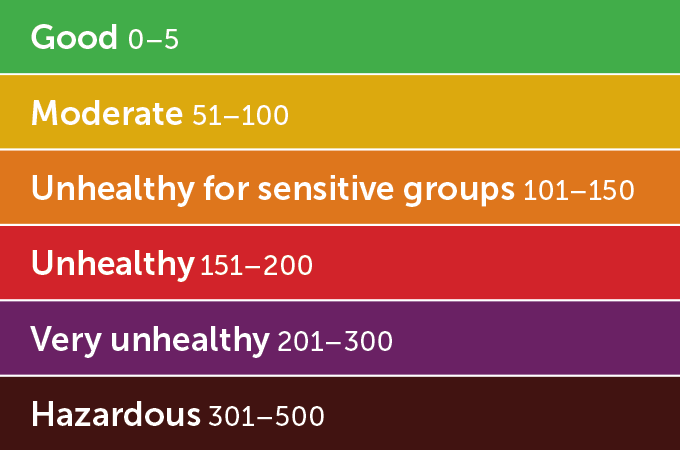
Human impacts
Smoke in the West is already having a tangible effect on human health in the East, says O’Dell, lead author of the 2021 GeoHealth study.
Reviewing smoke and health data from 2006 to 2018, O’Dell and colleagues found that more people visit emergency rooms and are hospitalized in the East than in the West from asthma problems attributable to smoke PM2.5. Asthma-related ER visits and hospitalizations were higher east of the Rockies in 11 of the 13 years.
Over the study period, an average of 74 percent of asthma-related deaths and 75 percent of asthma ER visits and hospitalizations attributable to smoke occurred east of the Rockies. Of the estimated 6,300 excess deaths from asthma complications due to smoke PM2.5 that occurred annually over the study period, more than 4,600 were in the East.
Smoke affects so many more people in the East primarily because more people live there, O’Dell notes. Her team defined “West” as west of the Rockies, with a population of 64 million, and “East” as east of the Rockies, home to 226 million people. In the West, smoke PM2.5 causes a higher portion of regional asthma deaths. In the East, it’s a lower portion of the total population, but a far higher total number of people affected.
“We may be already seeing the consequences of these fires on the health of residents who live hundreds or even thousands of miles downwind,” Buchholz said in a press release.
August peaks
Although aerosols, including fine particulate matter, from Pacific Northwest fires have been increasing since 2002, they began a sharp increase in 2012, spiking in the warm, dry summer months. As smoke from the Northwest wafted eastward, similar smaller spikes were seen in the central United States and northeastern North America.
North American seasonal atmospheric aerosol levels, by region
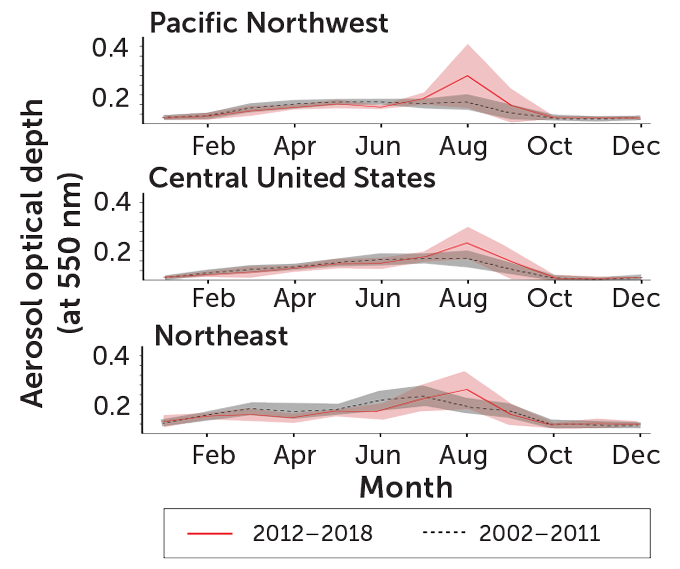
And, as Reeder and her family experienced last year, transported wildfire pollution is causing substantial particulate matter spikes in the central United States and northeastern North America, Buchholz and colleagues found. Pacific Northwest wildfires thus “have the potential to impact surface air quality, even at large distances downwind of the wildfires,” the team wrote, putting some 23 million people in the central United States and 72 million in northeastern North America at increased risk of health impacts from the imported wildfire smoke.
How far and where PM2.5 travels depends on weather patterns and how high wildfire smoke reaches — the stronger the fire, the longer it can last and the farther smoke can go, and thus the farther particulate matter can reach. Last year, far-away wildfires created unhealthy air quality conditions in locations from the Great Plains to New York City and Washington, D.C.
New York City saw some of its worst air quality in two decades. Philadelphia had two “code red” days — meaning air quality was unhealthy for all — because of the U.S. West and Canadian fires. In 2019, 2020 and 2021, those fires pushed PM2.5 to unhealthy levels in much of Minnesota. In fact, a 2018 study showed that wildfire smoke plumes now waft above Minnesota for eight to 12 days per month between June and September.
Air safety yardstick
The Air Quality Index, or AQI, ranges from 0 to 500, based on the amount of pollution in the air at a given time. Ground-level ozone, particulate matter (both PM10 and PM2.5), carbon monoxide, sulfur dioxide and nitrogen dioxide are the primary parameters considered in the index. Code orange (above a score of 100) is unhealthy for people with heart and lung disease, older adults, children and people with diabetes. Code red and above (151–500) is unhealthy for everyone.

T. TIBBITTS
Human impacts
Smoke in the West is already having a tangible effect on human health in the East, says O’Dell, lead author of the 2021 GeoHealth study.
Reviewing smoke and health data from 2006 to 2018, O’Dell and colleagues found that more people visit emergency rooms and are hospitalized in the East than in the West from asthma problems attributable to smoke PM2.5. Asthma-related ER visits and hospitalizations were higher east of the Rockies in 11 of the 13 years.
Over the study period, an average of 74 percent of asthma-related deaths and 75 percent of asthma ER visits and hospitalizations attributable to smoke occurred east of the Rockies. Of the estimated 6,300 excess deaths from asthma complications due to smoke PM2.5 that occurred annually over the study period, more than 4,600 were in the East.
Smoke affects so many more people in the East primarily because more people live there, O’Dell notes. Her team defined “West” as west of the Rockies, with a population of 64 million, and “East” as east of the Rockies, home to 226 million people. In the West, smoke PM2.5 causes a higher portion of regional asthma deaths. In the East, it’s a lower portion of the total population, but a far higher total number of people affected.
“We may be already seeing the consequences of these fires on the health of residents who live hundreds or even thousands of miles downwind,” Buchholz said in a press release.
August peaks
Although aerosols, including fine particulate matter, from Pacific Northwest fires have been increasing since 2002, they began a sharp increase in 2012, spiking in the warm, dry summer months. As smoke from the Northwest wafted eastward, similar smaller spikes were seen in the central United States and northeastern North America.
North American seasonal atmospheric aerosol levels, by region

R.R. BUCHHOLZ ET AL/NATURE COMMUNICATIONS 2022 (CC BY 4.0)
Vulnerable youth
“Asthma is a very widespread, common health condition,” says Yang Liu, an environmental scientist at Emory University in Atlanta. In the United States, about 25 million people have asthma, or 8 percent of adults and 7 percent of children, according to the U.S. Centers for Disease Control and Prevention.
Fine particulate matter can spark asthma attacks, but it can also be a danger to people without the condition. Children are especially vulnerable primarily because of physiology. Children breathe faster so they end up taking in more particulate matter, plus their lungs are smaller so more of their lung surface is likely to be damaged when they breathe in particulate matter. And their lungs are still developing, says Jennifer Stowell, an environmental epidemiologist at Boston University School of Public Health.
Stowell led a study, reported in the January Environmental Research Letters, estimating how much wildfire smoke will exacerbate asthma attacks in the West. Stowell, Liu and colleagues estimate that, in the 2050s, there will be an additional 155,000 asthma-related ER visits and hospitalizations per wildfire season in the West just from smoke PM2.5. The biggest concern, Stowell says, is for children and younger adults.
Aguilera, of Scripps, and her colleagues found associations between wildfire-specific PM2.5 and pediatric respiratory-related ER and urgent care visits. In San Diego County from 2011 to 2017, wildfire-specific PM2.5 was 10 times as harmful to respiratory health in children 5 and younger as ambient PM2.5, the researchers reported in 2021 in Pediatrics. In fact, the same increase in levels of PM2.5 from smoke versus ambient sources caused a 26 percent higher rate of ER or urgent care visits. The researchers didn’t note whether the children had preexisting asthma.
And even when a wildfire increased PM2.5 by a small amount, respiratory ER and urgent care visits in kids 12 and under increased, Aguilera and colleagues reported in 2020 in the Annals of the American Thoracic Society. “Even relatively smaller wildfires can still generate quite an impact on the pediatric population,” Aguilera says. “And really, any amount of PM or air pollution is harmful.”
Studies of nonhuman primates have also shown permanent effects of smoke on the young — results researchers expect would also apply to humans, given genetic similarities. In 2008, a group of infant rhesus macaques at the California National Primate Research Center at the University of California, Davis was exposed to high PM2.5 levels from a series of devastating wildfires in Northern California. Researchers have been comparing those monkeys with macaques born a year later that weren’t exposed to smoke.

“Asthma is a very widespread, common health condition,” says Yang Liu, an environmental scientist at Emory University in Atlanta. In the United States, about 25 million people have asthma, or 8 percent of adults and 7 percent of children, according to the U.S. Centers for Disease Control and Prevention.
Fine particulate matter can spark asthma attacks, but it can also be a danger to people without the condition. Children are especially vulnerable primarily because of physiology. Children breathe faster so they end up taking in more particulate matter, plus their lungs are smaller so more of their lung surface is likely to be damaged when they breathe in particulate matter. And their lungs are still developing, says Jennifer Stowell, an environmental epidemiologist at Boston University School of Public Health.
Stowell led a study, reported in the January Environmental Research Letters, estimating how much wildfire smoke will exacerbate asthma attacks in the West. Stowell, Liu and colleagues estimate that, in the 2050s, there will be an additional 155,000 asthma-related ER visits and hospitalizations per wildfire season in the West just from smoke PM2.5. The biggest concern, Stowell says, is for children and younger adults.
Aguilera, of Scripps, and her colleagues found associations between wildfire-specific PM2.5 and pediatric respiratory-related ER and urgent care visits. In San Diego County from 2011 to 2017, wildfire-specific PM2.5 was 10 times as harmful to respiratory health in children 5 and younger as ambient PM2.5, the researchers reported in 2021 in Pediatrics. In fact, the same increase in levels of PM2.5 from smoke versus ambient sources caused a 26 percent higher rate of ER or urgent care visits. The researchers didn’t note whether the children had preexisting asthma.
And even when a wildfire increased PM2.5 by a small amount, respiratory ER and urgent care visits in kids 12 and under increased, Aguilera and colleagues reported in 2020 in the Annals of the American Thoracic Society. “Even relatively smaller wildfires can still generate quite an impact on the pediatric population,” Aguilera says. “And really, any amount of PM or air pollution is harmful.”
Studies of nonhuman primates have also shown permanent effects of smoke on the young — results researchers expect would also apply to humans, given genetic similarities. In 2008, a group of infant rhesus macaques at the California National Primate Research Center at the University of California, Davis was exposed to high PM2.5 levels from a series of devastating wildfires in Northern California. Researchers have been comparing those monkeys with macaques born a year later that weren’t exposed to smoke.

At the California National Primate Research Center, rhesus macaques that were exposed to wildfire smoke early in life have immune disorders, nervous system changes and weakened lungs.
© 2014 KATHY WEST/CALIFORNIA NATIONAL PRIMATE RESEARCH CENTER/UC DAVIS
At around age 3, macaques exposed to smoke displayed immune disorders and reduced lung capacity, lung function and lung volume, says Hong Ji, a molecular biologist at UC Davis and the primate center who wasn’t involved with this study. The lungs look like they had fibrosis, Ji says. “Early life smoke exposure … changed the trajectory of lung development,” and it doesn’t appear to be reversible, she says.
The monkeys exposed to wildfire PM2.5 also have important changes to how their DNA works, Ji and colleagues reported in the January Environment International. Exposure to wildfire smoke in infancy can cause life-altering, long-term changes to the monkeys’ nervous and immune systems, as well as brain development, Ji says. Even worse, she says, the DNA changes are the type that can be passed down and may result in generational damage.
Even macaques born after in utero exposure to wildfire smoke can suffer cognitive, immune and hormone problems, primate center researchers reported April 1 in Nature Communications.
Now, Ji and colleagues have teamed with Rebecca Schmidt, a molecular epidemiologist at UC Davis who’s leading a study on the effects of wildfire smoke exposure on pregnant women and young children. This research group, as well as other teams, is also looking into whether PM2.5 is causing genetic changes to babies exposed to smoke in utero, Ji says. The more results gathered on the effects of wildfire PM2.5 on babies and children — and even in pregnancy — the more dangerous we realize it is, Ji says.
Chemical differences
Particulate matter changes as it travels through the atmosphere, both in volume and in chemistry. Some PM2.5 is emitted directly from fires, and some is born from chemicals and trace gases emitted from fires that get chemically processed in the atmosphere, Buchholz says. Reactions that happen in the smoke plume, combined with sunlight, can create even more PM2.5 downwind of the fires. How these particulates change chemically — through interactions between the atmosphere and the particulate matter, and between fire pollution and human pollution — and what that means for human health “is a really active area of research right now,” she says. “It’s super complicated.”
Epidemiological and atmospheric chemistry studies indicate that wildfire PM2.5 is more hazardous to human health than ambient PM2.5, says Stowell, the Boston epidemiologist. One such study compared particulate matter from Amazonian fires with urban sources such as vehicle exhaust in Atlanta. Nga Lee Ng, an atmospheric chemist at Georgia Tech, and colleagues found that smoke particulate matter is more toxic than urban particulate matter, “inducing about five times higher cellular oxidative stress,” Ng says. Oxidative stress damages cells and DNA in the body.
In addition, as smoke travels through the atmosphere and ages, it seems to become even more toxic, Ng says. Reactions between the particulate matter and sunlight and atmospheric gases change the particulate matter’s chemical and physical properties, rendering it even more potentially harmful. So, even though particulate matter dissipates over time and distance, “the health effects per gram are greater,” says Daniel Jaffe, an atmospheric chemist at the University of Washington Bothell.
That means that the studies of health effects near wildfires in the West may not represent the full story of how smoke from distant fires affects people in the East.
Liu, at Emory, hopes to see the U.S. government revisit policies related to what PM2.5 levels are dangerous, since they’re based on ambient and not wildfire-related PM2.5. In March, an EPA advisory panel recommended just that. In a letter to the agency, the Clean Air Scientific Advisory Committee wrote: “Regarding the annual PM2.5 standard, all CASAC members agree that the current level of the annual standard is not sufficiently protective of public health and should be lowered.” The committee added, “There is substantial epidemiologic evidence from both morbidity and mortality studies that the current standard is not adequately protective.”
Local communities throughout the country need to determine when to close schools or at least keep kids inside, Liu says, as well as when to advise people to close windows and turn on air purifiers. Good masks — N95 and KN95 — can help too (yes, masks that block viruses can also block particulate matter).
City, county and state governments also need to prepare the health care system to respond to increased asthma issues, Liu says. Some states are starting to respond. In 2017, for example, the Minnesota Pollution Control Agency increased its air quality monitoring stations around the state from two to 18. The agency is also working with the National Weather Service, the Minnesota Department of Health and the Minnesota Department of Transportation to better communicate air quality warnings.
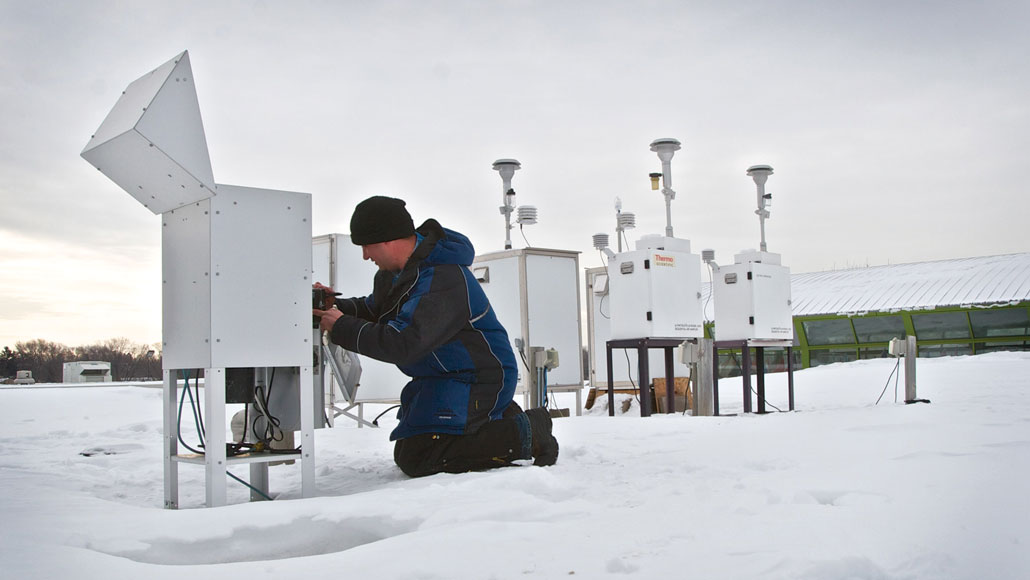
At around age 3, macaques exposed to smoke displayed immune disorders and reduced lung capacity, lung function and lung volume, says Hong Ji, a molecular biologist at UC Davis and the primate center who wasn’t involved with this study. The lungs look like they had fibrosis, Ji says. “Early life smoke exposure … changed the trajectory of lung development,” and it doesn’t appear to be reversible, she says.
The monkeys exposed to wildfire PM2.5 also have important changes to how their DNA works, Ji and colleagues reported in the January Environment International. Exposure to wildfire smoke in infancy can cause life-altering, long-term changes to the monkeys’ nervous and immune systems, as well as brain development, Ji says. Even worse, she says, the DNA changes are the type that can be passed down and may result in generational damage.
Even macaques born after in utero exposure to wildfire smoke can suffer cognitive, immune and hormone problems, primate center researchers reported April 1 in Nature Communications.
Now, Ji and colleagues have teamed with Rebecca Schmidt, a molecular epidemiologist at UC Davis who’s leading a study on the effects of wildfire smoke exposure on pregnant women and young children. This research group, as well as other teams, is also looking into whether PM2.5 is causing genetic changes to babies exposed to smoke in utero, Ji says. The more results gathered on the effects of wildfire PM2.5 on babies and children — and even in pregnancy — the more dangerous we realize it is, Ji says.
Chemical differences
Particulate matter changes as it travels through the atmosphere, both in volume and in chemistry. Some PM2.5 is emitted directly from fires, and some is born from chemicals and trace gases emitted from fires that get chemically processed in the atmosphere, Buchholz says. Reactions that happen in the smoke plume, combined with sunlight, can create even more PM2.5 downwind of the fires. How these particulates change chemically — through interactions between the atmosphere and the particulate matter, and between fire pollution and human pollution — and what that means for human health “is a really active area of research right now,” she says. “It’s super complicated.”
Epidemiological and atmospheric chemistry studies indicate that wildfire PM2.5 is more hazardous to human health than ambient PM2.5, says Stowell, the Boston epidemiologist. One such study compared particulate matter from Amazonian fires with urban sources such as vehicle exhaust in Atlanta. Nga Lee Ng, an atmospheric chemist at Georgia Tech, and colleagues found that smoke particulate matter is more toxic than urban particulate matter, “inducing about five times higher cellular oxidative stress,” Ng says. Oxidative stress damages cells and DNA in the body.
In addition, as smoke travels through the atmosphere and ages, it seems to become even more toxic, Ng says. Reactions between the particulate matter and sunlight and atmospheric gases change the particulate matter’s chemical and physical properties, rendering it even more potentially harmful. So, even though particulate matter dissipates over time and distance, “the health effects per gram are greater,” says Daniel Jaffe, an atmospheric chemist at the University of Washington Bothell.
That means that the studies of health effects near wildfires in the West may not represent the full story of how smoke from distant fires affects people in the East.
Liu, at Emory, hopes to see the U.S. government revisit policies related to what PM2.5 levels are dangerous, since they’re based on ambient and not wildfire-related PM2.5. In March, an EPA advisory panel recommended just that. In a letter to the agency, the Clean Air Scientific Advisory Committee wrote: “Regarding the annual PM2.5 standard, all CASAC members agree that the current level of the annual standard is not sufficiently protective of public health and should be lowered.” The committee added, “There is substantial epidemiologic evidence from both morbidity and mortality studies that the current standard is not adequately protective.”
Local communities throughout the country need to determine when to close schools or at least keep kids inside, Liu says, as well as when to advise people to close windows and turn on air purifiers. Good masks — N95 and KN95 — can help too (yes, masks that block viruses can also block particulate matter).
City, county and state governments also need to prepare the health care system to respond to increased asthma issues, Liu says. Some states are starting to respond. In 2017, for example, the Minnesota Pollution Control Agency increased its air quality monitoring stations around the state from two to 18. The agency is also working with the National Weather Service, the Minnesota Department of Health and the Minnesota Department of Transportation to better communicate air quality warnings.

Minnesota, after experiencing a rise in smoky summer days, has added extra air quality monitoring stations to improve local forecasts.
MINNESOTA POLLUTION CONTROL AGENCY
In the meantime, much more research is needed into the human health implications of increasing wildfire smoke, Buchholz says, as well as the chemical interactions in the atmosphere, how climate is changing fires, how fires change year after year, and how they impact the atmosphere, not to mention how different trees, buildings and other fuels affect particulate matter.
“Wildfires are perhaps one of the most visible ways that [climate change] is linked to health,” Stowell says. And the reality is, she says, “we’re going to see it remain as bad or worse for a while.”
Smoke gets on the brain
Health impact studies of air pollution, including wildfire smoke, have mostly focused on the lungs. But toxicologist Matthew Campen of the University of New Mexico in Albuquerque is looking at the brain.
In a study of the inflammatory effects of smoke PM2.5 on the brains of mice, Campen and colleagues found that inflammation in the lungs was modest compared with the “profound” inflammation in the brain, Campen says. Given what’s known about how damaging smoke can be in the lungs, to find even greater effects on the brain is troubling, he says.
The inflammatory effect on the mice’s brains was almost immediate, within 24 hours of exposure, the researchers reported in the March Toxicological Sciences. The particulates enter the body through the respiratory system, get in the blood, and are small enough to cross the blood-brain barrier and start affecting the brain. Inflammation has been linked with dementia in older people and neurodevelopmental issues in younger people, plus mood disorders like anxiety and depression, Campen says.
“I’m hoping that our study with mice spurs … epidemiologists to take a look,” he says. “The effects we see are much stronger and more worrisome than what we see in the lungs,” he says, but we don’t know yet at what PM2.5 levels the danger begins. “We need to explore this more rigorously.” — Megan Sever
A version of this article appears in the June 18, 2022 issue of Science News.
CITATIONS
R.R. Buchholz et al. New seasonal pattern of pollution emerges from changing North American wildfires. Nature Communications. Vol. 13. April 19, 2022. doi:10.1038/s41467-022-29623-8.
J.D. Stowell et al. Asthma exacerbation due to climate change-induced wildfire smoke in the Western US. Environmental Research Letters. Vol. 17. January 2022. doi:10.1088/1748-9326/ac4138.
R. Aguilera et al. Fine particles in wildfire smoke and pediatric respiratory health in California. Pediatrics. Vol. 147. April 2021. doi:10.1542/peds.2020-027128.
A.P. Brown et al. Long-term effects of wildfire smoke exposure during early life on the nasal epigenome in rhesus macaques. Environment International. Vol. 158. January 2022. doi:10.1016/j.envint.2021.106993.
D. Scieszka et al. Neuroinflammatory and neurometabolomic consequences from inhaled wildfire smoke-derived particulate matter in the western United States. Toxicological Sciences. Vol. 186. March 2022. doi:10.1093/toxsci/kfab147.
Related Stories
In the meantime, much more research is needed into the human health implications of increasing wildfire smoke, Buchholz says, as well as the chemical interactions in the atmosphere, how climate is changing fires, how fires change year after year, and how they impact the atmosphere, not to mention how different trees, buildings and other fuels affect particulate matter.
“Wildfires are perhaps one of the most visible ways that [climate change] is linked to health,” Stowell says. And the reality is, she says, “we’re going to see it remain as bad or worse for a while.”
Smoke gets on the brain
Health impact studies of air pollution, including wildfire smoke, have mostly focused on the lungs. But toxicologist Matthew Campen of the University of New Mexico in Albuquerque is looking at the brain.
In a study of the inflammatory effects of smoke PM2.5 on the brains of mice, Campen and colleagues found that inflammation in the lungs was modest compared with the “profound” inflammation in the brain, Campen says. Given what’s known about how damaging smoke can be in the lungs, to find even greater effects on the brain is troubling, he says.
The inflammatory effect on the mice’s brains was almost immediate, within 24 hours of exposure, the researchers reported in the March Toxicological Sciences. The particulates enter the body through the respiratory system, get in the blood, and are small enough to cross the blood-brain barrier and start affecting the brain. Inflammation has been linked with dementia in older people and neurodevelopmental issues in younger people, plus mood disorders like anxiety and depression, Campen says.
“I’m hoping that our study with mice spurs … epidemiologists to take a look,” he says. “The effects we see are much stronger and more worrisome than what we see in the lungs,” he says, but we don’t know yet at what PM2.5 levels the danger begins. “We need to explore this more rigorously.” — Megan Sever
A version of this article appears in the June 18, 2022 issue of Science News.
CITATIONS
R.R. Buchholz et al. New seasonal pattern of pollution emerges from changing North American wildfires. Nature Communications. Vol. 13. April 19, 2022. doi:10.1038/s41467-022-29623-8.
J.D. Stowell et al. Asthma exacerbation due to climate change-induced wildfire smoke in the Western US. Environmental Research Letters. Vol. 17. January 2022. doi:10.1088/1748-9326/ac4138.
R. Aguilera et al. Fine particles in wildfire smoke and pediatric respiratory health in California. Pediatrics. Vol. 147. April 2021. doi:10.1542/peds.2020-027128.
A.P. Brown et al. Long-term effects of wildfire smoke exposure during early life on the nasal epigenome in rhesus macaques. Environment International. Vol. 158. January 2022. doi:10.1016/j.envint.2021.106993.
D. Scieszka et al. Neuroinflammatory and neurometabolomic consequences from inhaled wildfire smoke-derived particulate matter in the western United States. Toxicological Sciences. Vol. 186. March 2022. doi:10.1093/toxsci/kfab147.
Related Stories
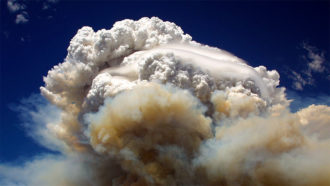

No comments:
Post a Comment